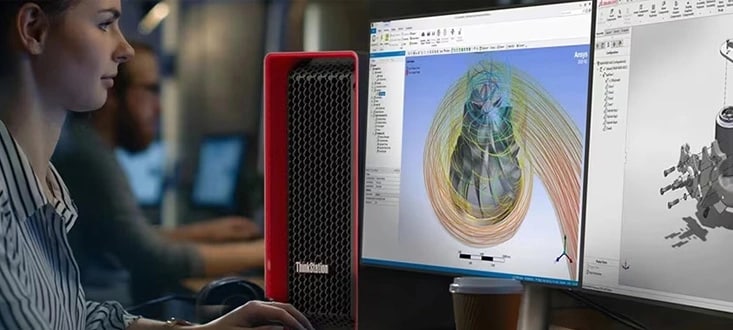-
Shop Lenovo Store
|
-

 Join a Community
Join a Community -

 Contact Us
Contact Us -

 Account
Account -

 Cart
Cart
Intel Core Ultra processors for laptops
Advanced on-the-go computing with an ‘AI Boost’
With its Intel® Core™ Ultra processors, Intel Corp. opened a new world of laptop power and portability for the mid-2020s. Discrete-level built-in graphics for creating and gaming. New power management techniques to extend battery life in high-performance settings. And pulling it all together—an innovative on-chip Artificial Intelligence engine that accelerates today's all-important AI workloads.
Lenovo is adding Core Ultra processors across our line-up of work, home, and gaming laptops (product selection and stock may vary). But don't mistake these new chips for just another next-generation CPU. Intel Core Ultra processors are built differently so they perform differently:
- Dedicated processing support for AI-enabled tasks
- Available Intel® Arc™ graphics1 for superior visuals
- Specialized low-power processing to limit power drain
In this article, we’ll take a deeper look at Intel Core Ultra processors, their performance-enhancing Intel® AI Boost technology, and why Intel says its new premium processor brand introduces a new age of “the AI PC.” But first, let’s talk names and numbers.
Intel Core Ultra: A new name—and much more
Intel® Core™ Ultra processors were officially announced in late 2023 (until then, they were known only by their code name, Meteor Lake). Lenovo shipped our first Core Ultra-based laptops just a few weeks later.
Reviewers quickly focused on the new Intel® AI Boost feature and other mobile computing innovations (see below). But the first thing everyday PC shoppers noticed was Intel’s updated processor naming and numbering conventions:
- No ‘i’ designation—Starting with Intel Core Ultra, Intel no longer uses an “i” in processor names such as 5i or 7i. The new chips are Core Ultra 5, Core Ultra 7, and so on. The mainstream Intel® Core™ processor brand dropped the “i,” too, becoming simply Core 3, Core 5, etc.
- Streamlined selection—Intel has consolidated its mobile processor line-up, too. Going forward, the Intel Core brand will offer Core 3, Core 5 and Core 7 chips, but not Core 9 ones. The Intel Core Ultra brand, meanwhile, will offer only Core Ultra 5, Core Ultra 7 and Core Ultra 9 models.
- No ‘generation’ number—The new Core Ultra chips are not referred-to by generation, at least initially. While the hugely popular Intel Core line will soon be up to “14th gen” and higher, Intel Core Ultra chips are so unique they get their own, new name.
So, if you’re looking for an Intel-powered PC, you have a choice: the mainstream Intel Core brand and the premium Intel Core Ultra brand—the latest and greatest.
Intel Core Ultra: Giving AI workloads a ‘boost’
Perhaps the biggest innovation in premium Intel® Core™ Ultra processors is Intel® AI Boost—what the company calls a dedicated “engine" for computing Artificial Intelligence (AI) workloads. Using a re-engineered manufacturing process, Intel added a new processor sector called a Neural Processing Unit (NPU) that's integrated into each chip and purpose-built for AI chores.
It’s the first time this productivity-enhancing technology has appeared in Intel mobile processors. Why does it matter? Well, AI is everywhere—or so it seems. Operating systems try to predict your next request. Software can write for you by analyzing what you’ve written before.
In short, millions of AI-focused calculations now compete with all your other requests for processing power. So, why not give things a “boost?”
Purpose-built to speed AI processing
In Intel® Core™ Ultra processors with Intel® AI Boost, many of the complex algorithms and calculations that make AI so "magic" are performed in the new NPU sector of the chip, which is specially designed to work using minimal power. This frees the majority of your power and the remaining chip sectors (that is, the central processing unit (CPU) and graphics processing unit (GPU) to focus on your other tasks. In the end, you get:
- Super-charged AI performance
- Greater power efficiency
- Reduced heat generation
For example, take graphics, where AI is increasingly important. With dedicated processing capacity working solely on AI requests, images can be more immersive and responsive to each new user input. And since Core Ultra processors do more with less energy, your laptop draws less power—a boon for demanding users, whether you’re creating content on a mobile workstation or running a souped-up laptop gaming rig.
Cooler, more efficient performance
The new architecture continues Intel's move to segment its processors so that different kinds of tasks are handled by specialized portions of the chip—the so-called “performance cores” and “efficient cores.” Intel® Core™ Ultra processors segment tasks even further, using AI and other tools to distribute each operation to a specific, dedicated segment of the chip that's best suited to the job, whether it’s a performance core, an efficient core, or both.
Business professionals, gamers and other users get dramatically improved performance—even compared to other recent, high-end Intel processors—with less power consumption and heat build-up. You get speedier, more efficient game graphics (or engineering calculations, or architectural renderings) because Intel Core Ultra chips instantly route each request to the best location:
- low-powered sections of the processor that are built to handle billions of the simplest tasks super-efficiently, and while staying relatively cool.
- higher-powered sections of the processor that are reserved for advanced, hyper-critical calculations that are worth using more power and creating more heat.
There are two versions of Intel Core Ultra processors. Core Ultra H Series designs (model numbers such as “1xxH…”) are optimized for performance and visual immersion while running highly efficiently. Core Ultra U Series designs (model number such as “1xxU…”) are built for efficient performance and immersion too, but with increased focus on long battery life.
Of course, there’s more to Core Ultra processors than AI Boost and power efficiency. Keep reading to learn how these new chips can deliver discrete-quality integrated graphics, enhanced connectivity options, and a growing list of software and hardware vendors that are already using the technology.
Intel Core Ultra: Improved graphics, connectivity & more
Laptop users work from just about everywhere, so they need the latest, high-speed connectivity options. And gamers and content professionals need top-flight graphics—even when they’re on-the-go. For these users, Intel® Core™ Ultra processors go beyond AI acceleration to offer even more advancements such as discrete-level integrated graphics and the latest WiFi technology.
Integrated Intel Arc graphics
In a big development for demanding mobile graphics users, select Intel® Core™ Ultra processors feature integrated Intel® Arc™ graphics.1 Originally available only in discrete GPU configurations, Intel Arc graphics enable high-frame rate, low-latency gaming and other visual work—now with less power drain thanks to being built-into the Core Ultra processor itself.
According to the company, Intel Arc technology delivers up to two times2 the 3D graphics performance of Intel® Iris® XeLP, another popular integrated graphics offering from Intel. For gamers, in particular, this means smoother, more power-efficient gameplay on today’s most popular games.
Two things, in particular, help make Intel Arc graphics on Core Ultra processors so special for mobile users:
- AI-enhanced upscaling using Xe Super Sampling (XeSS). This feature uses AI algorithms and hardware acceleration to deliver more immersive, high definition visuals, even at performance settings that might otherwise force lower resolution rendering.
- Longer time unplugged with Endurance Gaming mode. This feature can dynamically adjust the power provided to the integrated graphics—dropping frame rates (and battery drain) when it knows it won’t affect your gameplay.
Whether you’re editing fast-action film scenes while traveling or playing a favorite multi-player video game sitting under a tree, Intel says Intel Arc graphics on are a game-changer. [At time of launch, Intel Arc graphics were only available on select Core Ultra H Series processors.]
WiFi 7 & Thunderbolt 4
In other big news, Intel® Core™ Ultra processors are the company’s first to include support for WiFi 7, a big step up from earlier WiFi generations. WiFi 7 is said to deliver consistent low-latency connections at speeds of 5 Gbps or higher. Wireless data transfers are faster thanks to 320 MHz channels (twice the capacity as earlier WiFi channels), and it supports far more simultaneous connections—ideal for laptop users in crowded locations.
Intel Core Ultra processors also support a Thunderbolt™ 4 connectivity for up to 40 Gbps of high-speed wired data and video transfers. It can deliver up to 100 watts of charging power (with another 15 watts ready to power connected accessories) and carries enough data to support one 8K display or two 4K displays running at 60hz each.3
Note that these connectivity options may vary by manufacturer and country, so be sure to check the specifications of any model you’re considering. For example, some wireless channels are not available everywhere, so in some countries, Core Ultra-powered devices may offer WiFi 6 or WiFi 6E.
‘ISV Roadmap’—Ready to go to work
Even before its latest chips were released, Intel was working with independent hardware vendors (IHVs) and software vendors (ISVs) to build an “ISV Roadmap” or ecosystem of real-world use cases and tools for the coming generation of AI PCs. Soon these groups had identified more than 300 AI accelerated features that will benefit from the unique capabilities of Intel® Core™ Ultra processors.
Involved companies include Adobe, Audacity, BlackMagic, BufferZone, CyberLink, DeepRender, Fortemedia, MAGIX, VideoCom, Webex, XSplit and Zoom. Together with Intel, they’re working on new ways to use AI acceleration to enhance PC audio effects, content creation, gaming, security, streaming, video collaboration and more.
Look for Intel Core Ultra processors throughout Lenovo’s wide array of work, home, and gaming laptops. [Product selection and in-stock availability will vary.]
Intel Core Ultra: The laptop CPU with an AI ‘boost’
In a world where processor advances have been measured mostly in terms of the number of cores and threads in each chip, Intel has done something different.
Yes, its premium Intel® Core™ Ultra processors have great numbers: at launch, they came with up to 16 cores and 22 threads—impressive capacity for any laptop processor. And with available integrated Intel® Arc™ graphics1 and advanced connectivity options, Core Ultra-powered systems can give gamers and content pros a leg up on the competition.
But it’s the focus on processing AI workloads—using the least energy it can—that distinguishes the Intel Core Ultra brand. With more and more of our technology (and our jobs) relying on artificial intelligence, it makes sense to use tools such as Intel® AI Boost to process it as rapidly and efficiently as possible.
1 Intel® Arc™ graphics only available on select Intel® Core™ Ultra H series processor powered systems with dual channel memory. OEM enablement required; check with OEM or retailer for system configuration details.
2 Intel® Arc™ graphics delivers up to 2x performance of Iris® XeLP graphics, showing a 2x generational leap. See intel.com/performanceindex (graphics) for details. Results may vary.
3 Some computers and monitors may require support for Display Stream Compression (DSC) to support higher resolutions.
Intel, the Intel logo, Intel Evo, Intel Core, and Intel vPro are trademarks of Intel Corporation or its subsidiaries.




